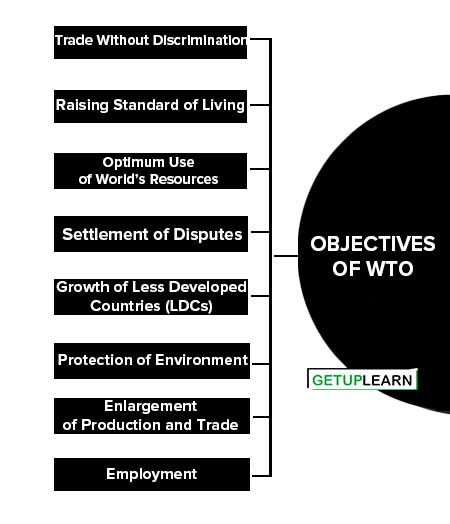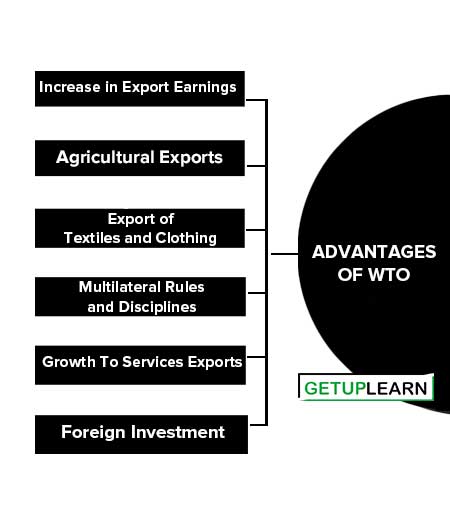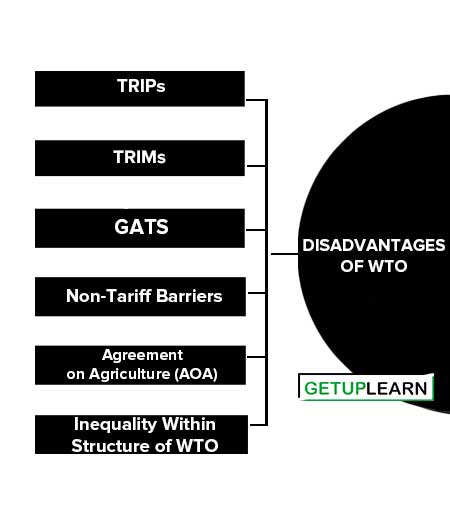Table of Contents
What is WTO?
After the Second World War, many countries planned down to be together to work on ways and means to promote international trade. The result was the signing of (the GATT) General Agreement on Tariffs and Trade by 23 countries in 1947. India was one of the founding members of GATT. GATT was created to reduce the global depression and to liberalize and regulate world trade by cutting down on tariff barriers.
In 1995 GATT has been replaced by WTO. WTO is wider in scope as it regulates both world trade in goods, as well as in services intellectual property rights, and investment.
In Jan 2010, the membership of WTO was 153 countries. Its rules and policies are the outcome of negotiations among WTO members. Thus, it is a member-driven, consensus-based organization.
Objectives of WTO
The principal objectives of WTO are explained below:
- Trade Without Discrimination
- Raising Standard of Living
- Optimum Use of World’s Resources
- Settlement of Disputes
- Growth of Less Developed Countries (LDCs)
- Protection of Environment
- Enlargement of Production and Trade
- Employment

Trade Without Discrimination
Trade without discrimination was achieved through the application of the Most Favoured Nation (MFN) Principle. As per the MFN clause, a member nation of WTO must provide the same preferential treatment to other member nations which it gives to any other member nation.
Raising Standard of Living
Raising the income level and standard of living and ensuring full employment of the citizens of its member nations.
Optimum Use of World’s Resources
Ensuring optimum use of the world’s resources and, thereby, expanding world production and trade of goods as well as services.
Settlement of Disputes
Settlement of disputes among members through consultation, conciliation, and as a last resort through dispute settlement procedures.
Growth of Less Developed Countries (LDCs)
It recognizes the need for positive efforts designed to ensure that developing countries especially the LDCs, secure a better share of growth in international trade.
Protection of Environment
Preserving and protecting the environment of the world so as to benefit all the nations of the world.
Enlargement of Production and Trade
WTO aims to enlarge the production and trade of goods as well as services.
Employment
WTO aims at generating full employment in economies and increase effective demand.
Advantages of WTO
The following are the benefits or advantages of WTO:
- Increase in Export Earnings
- Agricultural Exports
- Export of Textiles and Clothing
- Multilateral Rules and Disciplines
- Growth To Services Exports
- Foreign Investment

Increase in Export Earnings
Estimates made by World Bank, Organisation for Economic Co-operation and Development (OECD), and the GATT Secretariat, show that the income effects of the implementation of the Uruguay Round package will be an increase in traded merchandise goods. It is expected that India’s share in world exports would improve.
Agricultural Exports
Reduction of trade barriers and domestic subsidies in agriculture is likely to raise international prices of agricultural products. India hopes to benefit from this in the form of higher export earnings from agriculture.
This seems to be possible because all major agriculture development programs in India will be exempted from the provisions of the WTO Agreement.
Export of Textiles and Clothing
With the phasing out of MFA (Multi – Fibre Arrangement), exports of textiles and clothing will increase and this will be beneficial for India. The developed countries demanded a 15-year period of phasing out of MFA, while the developing countries, including India, insisted that it be done in 10 years.
The Uruguay Round accepted the demand of the latter. But the phasing out of Schedule favors the developed countries because a major portion of the quota regime is going to be removed only in the tenth year, i.e. 2005. The removal of quotas will benefit not only India but also every other country.
Multilateral Rules and Disciplines
The Uruguay Round Agreement has strengthened Multilateral rules and disciplines. The most important of these relates to anti-dumping, subsidies and countervailing measures, safeguards, and dispute settlement.
This is likely to ensure greater security and predictability of the international trading system and thus create a more favorable environment for India in the New World Economic Order.
Growth To Services Exports
Under the GATS agreement, member nations have liberalized the service sector. India would benefit from this agreement. For Eg:- India’s services exports have increased from about 5 billion US $ in 1995 to 96 billion US $ in 2009-10. Software services accounted for about 45% of service exports.
Foreign Investment
India has withdrawn a number of measures against foreign investment, as per the commitments made to WTO. As a result of this, foreign investment and FDI have increased over the years. A number of initiatives have been taken to attract FDI in India between 2000 and 2002. In 2009-10, the net FDI in India was US $ 18.8 billion.
Disadvantages of WTO
The negative impact, problems, or disadvantages of WTO agreements on the Indian economy:
- TRIPs
- TRIMs
- GATS
- Non-Tariff Barriers
- Agreement on Agriculture (AOA)
- Inequality Within Structure of WTO

TRIPs
The Agreement on TRIPs at Uruguay Round weighs heavily in favor of Multinational Corporations and developed countries as they hold a very large number of patents. Agreement on TRIPs will work against India in several ways and will lead to a monopoly of patent-holding MNCs.
As a member of WTO, India has to comply with the standards of TRIPs. The negative impact of the agreement on TRIPs on the Indian economy can be stated as follows:
- Pharmaceutical Sector
- Agriculture
- Microorganisms
Pharmaceutical Sector
Under the Patents Act, 1970, only process patents were granted to chemicals, drugs, and medicines. This means an Indian pharmaceutical company only needed to develop and patent a process to produce and sell that drug. This proved beneficial to Indian pharmaceutical companies as they were in a position to sell quality medicines at low prices both in domestic as well as in international markets.
However, under the agreement on TRIPs, product patents need to be granted. This will benefit the MNCs and it is feared that they will increase the prices of medicines heavily, keeping them out of reach of the poor. Again many Indian pharmaceutical companies may be closed down or taken over by large MNCs.
Agriculture
The Agreement on TRIPs extends to agriculture through the patenting of plant varieties. This may have serious implications for Indian agriculture. Patenting of plant varieties may transfer all gains in the hands of MNCs who will be in a position to develop almost all new varieties with the help of their huge financial resources and expertise.
Microorganisms
The Agreement on TRIPs also extends to Microorganisms as well. Research in microorganisms is closely linked with the development of agriculture, pharmaceuticals, and industrial biotechnology. Patenting of microorganisms will again benefit large MNCs as they already have patents in several areas and will acquire more at a much faster rate.
TRIMs
Agreement on TRIMs provides for the treatment of foreign investment on par with domestic investment. This Agreement too weighs in favour of developed countries. There are no provisions in the Agreement to formulate international rules for controlling restrictive business practices of foreign investors.
In the case of developing countries like India, complying with the Agreement on TRIMs would mean giving up any plan or strategy of self-reliant growth based on locally available technology and resources.
GATS
One of the main features of the Uruguay Round was the inclusion of trade in services in negotiations. This too will go in favor of developed countries. Under GATS agreements, the member nations have to open up the services sector for foreign companies.
The developing countries including India have opened up the services sector in respect of banking, insurance, communication, telecom, transport, etc. to foreign firms. The domestic firms of developing countries may find it difficult to compete with giant foreign firms due to a lack of resources & professional skills.
Non-Tariff Barriers
Several countries have put up trade barriers and non-tariff barriers following the formation of WTO. This has affected the exports from developing countries.
The Union Commerce Ministry has identified 13 different non-tariff barriers put up by 16 countries against India. For eg. MFA (Multi-fibre arrangements) put by the USA and European Union is a major barrier for Indian textile exports.
Agreement on Agriculture (AOA)
The AOA is biased in favor of developed countries. The issue of food security in developing countries is not addressed adequately in AOA. The existence of global surpluses of food grains does not imply that poor countries can afford to buy them. The dependence on necessary items like food grains would adversely affect the Balance of Payment position.
Inequality Within Structure of WTO
There is inequality within the structure of WTO because the agreements and amendments are in favor of developed countries. The member countries have to accept all WTO agreements irrespective of their level of economic development.
FAQs About the What is WTO?
What are the objectives of WTO?
The following are the objectives of WTO:
1. Trade Without Discrimination
2. Raising Standard of Living
3. Optimum Use of World’s Resources
4. Settlement of Disputes
5. Growth of Less Developed Countries (LDCs)
6. Protection of Environment
7. Enlargement of Production and Trade
8. Employment.
What are the advantages of WTO?
The following are the advantages of WTO:
1. Increase in Export Earnings
2. Agricultural Exports
3. Export of Textiles and Clothing
4. Multilateral Rules and Disciplines
5. Growth To Services Exports
6. Foreign Investment.
What are the disadvantages of WTO?
These are the some disadvantages of WTO: 1. TRIPs 2. TRIMs 3. GATS 4. Non-Tariff Barriers 5. Agreement on Agriculture (AOA) 6. Inequality Within Structure of WTO.



